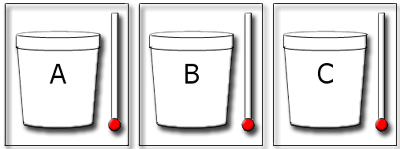Teaching and Learning Focus
To introduce students to ideas about temperature, they first need to realize that liquids and gases can be warmer or cooler in different situations. This first investigation question is designed to help your students understand that air and water can exist at different temperatures.
Materials Needed
|
Cup A |
Water slightly warmer than body temperature, about |
100 °F/38 °C |
|
Cup B |
Cold water at a temperature of about |
45 °F/7 °C |
|
Cup C |
Water that is at or near room temperature |
72 °F/22 °C |
- 3 foam drink cups marked A, B and C large enough to put hands in - each should contain water at the different temperatures shown below:
- A fourth drink cup marked D, with water that is not as hot as cup A, but also not the same as cup B or C
- Blank alcohol thermometers (These are available from several science supply catalogs. See, for instance, Sciencekit. Alternatively, you could detach thermometer bulb/tubes from their measurement scales).
- Regular alcohol thermometers calibrated in °F and °C
- Paper towels
Safety
This investigation question is considered generally safe to do with students. You should check that the heated water is not too hot to handle. Please review the investigation for your specific setting, materials, students, and conventional safety precautions.
Setting the Scene
To introduce students to ideas about temperature, they first need to realize that materials can exist at different levels of heat. This first investigation is designed to get them started on that learning pathway.
Hold up a cup of very hot water-hot enough that steam is coming off of it. Ask the students to describe it. (Among other things, they will say that it is "hot".) Next, hold up a cup of water that obviously has ice floating in it. Ask students to describe this cup. (Among other things, they will say that it is "cold"). Now, pour some of the hot water and most of the cold water into a third cup and ask students to describe it. (They are likely to say the water is "warm", or it is "cool"). Finally, pour the remaining cold water into the first cup, with the remaining hot water, and ask about it. Among the answers for the last cup are likely to be descriptions including "warm" and "hot", and maybe even "hotter than warm". Some students may revise one or more responses to include "cool" and/or "warm" in place of each other. While terms such as "warm" and "cool" are relative terms, we can get an idea of how they can be used in a sequence. What if we could not feel how hot something is directly? How else could we put things in sequence by how hot they are?
Presenting the Investigation Question
Introduce your students to the investigation question: " How can we put things in a sequence by how hot they are?"
Have your students discuss the question in pairs, then in groups, and then as a whole class. Record their answers on the flipchart.
Have your students brainstorm ideas about how this investigation question could be investigated.
- Design an experiment that could be used to test the investigation question.
- What materials would be needed?
- What would you have to do?
- What would be measured?
- How long would the experiment take?
Assessing What Your Students Already Know
Here are some pictures and initial questions that your students can discuss, in pairs, groups and as a whole class:

© Bruce Molnia, Terra Photographics
- What do you think the air would feel like if you were standing here?
- If you were here, how would you be dressed?
- How can you tell when air is cooler than where you are now?
- What might the air temperature be in this place?

© Larry Fellows, Arizona Geological Survey
- What do you think the air would feel like if you were here?
- If you were here, how would you be dressed?
- How can you tell when air is warmer than where you are now?
- What is temperature and how can it be measured?
Have your students report out their ideas and make a list of them. From their responses you will get a good sense of the understanding they bring to the concept of temperature. (Some may have an understanding of how temperature can be measured with a thermometer - others may not).
Exploring the Concept
- Introduce the three cups of water to your students. Have them to feel the water in each then arrange them in the order of coldest to warmest. (B, C, A.) Ask your students to explain how they are distinguishing hot from cold, warm or cool. What are they using to detect the differences in the water samples? (They are using their sense of "touch.")
- Ask your students to think about other ways they could tell the heat differences in the cups? (Some may mention using a thermometer. If so, tell your students that they are going to investigate thermometers.)
- Give your students a blank thermometer tube. Ask them to describe what they see. Have your students observe and record what happens when they insert the thermometer tube first in B, the cold water, then in C, the warmer water, and finally in A, the hot water. (They should see the differences in the height of the liquid in the tube.)
- Have your students draw what they see on the sheet provided below.
Adobe PDF (37 KB) | Word Document (30 KB)
- Immediately following their observations, ask the students to display their drawings so that they can share and compare. The relative height of the red column in each tube is all that is important, not the exact length. As described above, A should be higher than B, and B should be higher than C.
- Give each group a fourth cup marked D with water that is between the temperatures of those in the first three cups (different groups can have different temperatures from one another.) For safety reasons, do not make the water in the fourth cup hotter than the hottest water, which was in cup A. If possible, have a lid on this cup that allows the thermometer tube to be put through, but does not allow the students to touch the water.
- Tell the students to determine where this cup should go relative to the other three in the sequence without touching the water in cup D-using only their thermometer tube.
- Discuss how the placement of cup D was determined by each group. If groups disagree about the placement of D in the sequence, ask them if it might be possible that the groups had water of different temperatures. How could they check that with their equipment? (Place the thermometer tube in cup D for the different groups and compare how long the red column is for each.)
Applying Students' Understanding
To assess your students understanding of what a thermometer tube is and how it is used, ask them to describe what they have observed:
- What happened as the thermometer tube was placed in each of the four containers? (The level of the liquid in thermometer changed. It was highest in A and lowest in B.)
Help your students understand that the warmed liquid takes up more room inside the tube. (When warmed, the liquid expands. That's the way a liquid-filled thermometer works, whether immersed in liquid or hanging in the air. The red coloring is added to make it easier to see.) The thermometer tube provides a reliable way to judge temperature that does not depend on the sense of touch, which can be unreliable under some circumstances.
Revisiting Investigation Question 1
Complete this investigation by asking your students to reflect on its investigation question and how their answers may have changed as a result of what they have learned. While our sense of touch allows us to put things in a relative sequence from warmest to coolest, as the differences in temperature become smaller, our sense of touch can be less reliable than an instrument. When we are in situations where we cannot use touch, some kind of instrument must be used.
To help make the point about the sense of touch being unreliable, send one student out of the room for a few moments while you prepare the following demonstration. On a table where all students can see, set up three containers of water that are large enough for a student to place her hand in:
- a container of water that is very warm (but not hot) to the touch,
- a container of water that is very cool to the touch,
- a container of water that is room temperature.
Cover the containers with a towel so they are not visible. Have the student return from the hallway and blindfold her. Explain that she is going to put one hand in warm water and the other in cool water, then you will help her move each to another container. Guide the student's hands into the warm water and the cool water. Then, one at a time, guide her hand into the room temperature water and ask her to describe it to the class. When she moves from the warm water to the room temperature water, she will describe it as cool. When she moves from the cool water to the room temperature water, she will describe it as warm. Touch is a relative sense, in that we sense the difference in temperature between our current sensation and the new one, not the absolute temperature.
Weather Unit Sections
How can we put things in a sequence by how hot they are?
How much can air temperature change during a day?
